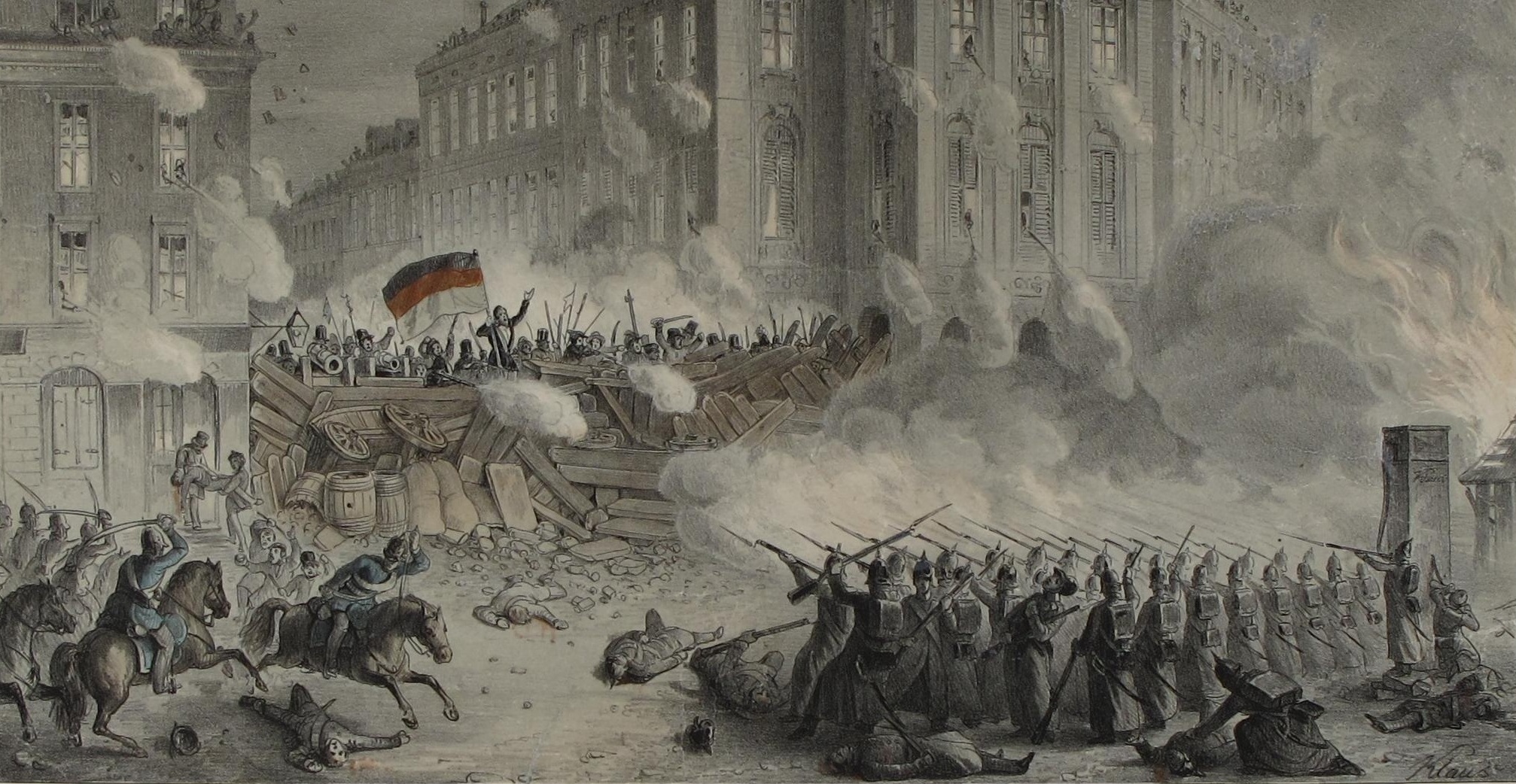
漢德百科全書 | 汉德百科全书

德国在历史上曾是一个长期分裂的国家,境内诸 侯林立。19世纪50—60年代,德意志资本主义经济迅速发展,工业总产值超过法国,居世界第三位。当时分裂的诸邦中,奥地利和普鲁士是最强大的两个君主 国。奥地利国势日衰,缺乏振兴国家的措施,而普鲁士统治者为排除奥地利的势力,大力发展农业,实力不断增强。1849年和1859年,普鲁士两次企图在自 己领导下实现德国的统一,但都因奥地利的阻挠而失败。
1861年,普鲁士的威廉一世继承王位后,任 命奥托·冯·俾斯麦(1815—1898)为内阁首相兼外交大臣。俾斯麦对于普鲁士有能力统一德意志深信不疑。1832年读大学时,在当年美国独立战争纪 念日那天,他同一位美国朋友莫特利用25瓶香槟酒打赌:25年内德意志必然统一。虽然德意志统一比他的赌注晚了10年,但毕竟在他的手中实现了。


Deutsches Reich ist der Name des deutschen Nationalstaates zwischen 1871 und 1945. Der Name war bis 1943 zugleich auch die staatsrechtliche Bezeichnung Deutschlands. Ab da hieß das Land amtlich – jedoch nicht offiziell proklamiert – Großdeutsches Reich.
Der Ausdruck Deutsches Reich wird gelegentlich auch gebraucht, um das mit dem deutschen Sprachraum nicht übereinstimmende Heilige Römische Reich zu bezeichnen: ein übernationales, letztlich überstaatliches Herrschaftsgebilde, das ab dem 15./16. Jahrhundert mit dem Zusatz „Deutscher Nation“ versehen worden war.[1]
Im Jahr 1848 entstand während der Märzrevolution ein „Deutsches Reich“ als deutscher Bundesstaat. Dessen Reichsregierung und damit die provisorische Verfassung wurde vom Bundestag des Deutschen Bundes anerkannt.[2] Im Frühjahr 1849 jedoch ließ der preußische König Friedrich Wilhelm IV. die Revolution niederschlagen, und die ausgearbeitete Verfassung konnte sich nicht durchsetzen.
Beim Deutschen Reich des 19. und 20. Jahrhunderts unterscheidet man allgemein mehrere Perioden: die Monarchie des kaiserlichen Deutschland (1871–1918), die pluralistische, semipräsidentielle Demokratie der Weimarer Republik (1918/19–1933) und die Diktatur der Nationalsozialisten (1933–1945). In der folgenden Übergangsperiode des besetzten Deutschland bis 1949 kam die Bezeichnung bereits weitgehend außer Gebrauch. In der zunächst umstrittenen Frage, ob das Deutsche Reich nach 1945 fortbestanden habe, setzte sich ab Ende der 1940er Jahre und schließlich mit dem Urteil des Bundesverfassungsgerichts vom 31. Juli 1973 die These durch, dass das Deutsche Reich den Zusammenbruch von 1945 überdauert habe. Die Bundesrepublik sei zwar nicht dessen „Rechtsnachfolger“, aber als Staat mit dem Staat „Deutsches Reich“ identisch, hinsichtlich der räumlichen Ausdehnung allerdings „teilidentisch“.






拿破仑战争之后,哈布斯堡的奥地利皇帝宣布放弃神圣罗马帝国皇帝称号,神圣罗马帝国灭亡。德意志诸邦国组成了松散的德意志邦联(Deutscher Bund)。有38个组成成员,包括: 1个帝国:奥地利 8个王国: 普鲁士 丹麦(其国王属于荷尔斯泰因-哥道普家族,作为荷尔斯泰因公国的领主而享有德意志邦联成员身份,直到1864年的普丹战争为止) 巴伐利亚 萨克森 巴登 荷兰(其国王作为卢森堡大公而享有德意志邦联成员身份) 英国(国王源自德国汉诺威公国,享有德意志邦联成员身份) 黑森大选帝侯 3个大公国: 符滕堡 黑森-卡塞尔 萨克森-魏玛 11个公国: 萨克森-哥达 萨克森-柯堡-梅宁根 萨克森-阿尔滕堡 萨克森-柯堡-哥达 不伦瑞克-沃芬巴赫 荷尔斯泰因-奥尔登堡 梅克伦堡-什未林 梅克伦堡-斯特雷利茨 安哈特-德骚 安哈特-伯恩堡 安哈特-哥滕 11个亲王领地: 霍亨佐伦-黑兴根 霍亨佐伦-西格马林根 拿骚 列支敦士登 施瓦岑堡-桑德豪森 施瓦岑堡-鲁多尔施塔特 瓦尔戴克-皮埃蒙特 长系琉森 幼系琉森 绍姆堡-利佩 利佩 4个自由市: 吕贝克 法兰克福(美因河), 不莱梅 汉堡 德意志邦联使用黑红金三色旗,是1813年由吕佐率领的自由军团的旗帜。墨黑和金黄两色,是神圣罗马帝国的代表色,被邦联中最强大的成员 - 奥地利帝国所沿用,而受法国大革命宣扬自由主义的影响参加吕佐军团的德国青年,则在这面旗帜中加入代表革命和自由的红色。1848年5月7日,在法兰克福召开的德意志邦联议会接受三色旗为象征德意志的旗帜。

Heiliges Römisches Reich (lateinisch Sacrum Imperium Romanum oder Sacrum Romanum Imperium)[1] war die offizielle Bezeichnung für den Herrschaftsbereich der römisch-deutschen Kaiser vom Spätmittelalter bis 1806. Der Name des Reiches leitet sich vom Anspruch der mittelalterlichen römisch-deutschen Herrscher ab, die Tradition des antiken Römischen Reiches fortzusetzen und die Herrschaft als Gottes heiligen Willen im christlichen Sinne zu legitimieren.
Das Reich bildete sich im 10. Jahrhundert unter der Dynastie der Ottonen aus dem ehemals karolingischen Ostfrankenreich heraus.[2] Mit der Kaiserkrönung Ottos I. 962 knüpften die römisch-deutschen Herrscher (wie zuvor die Karolinger) an die Idee des erneuerten Römerreiches an, woran bis zum Ende des Reiches zumindest prinzipiell festgehalten wurde. Das Gebiet des Ostfrankenreichs wurde erstmals im 11. Jahrhundert in den Quellen als Regnum Teutonicum oder Regnum Teutonicorum („Königreich der Deutschen“) bezeichnet; es handelte sich aber nicht um den offiziellen Reichstitel.[3] Der Name Sacrum Imperium ist für 1157 und der Titel Sacrum Romanum Imperium für 1254 erstmals urkundlich belegt. Der Zusatz Deutscher Nation (lateinisch Nationis Germanicæ) wurde ab dem späten 15. Jahrhundert gelegentlich gebraucht.[4] Zur Unterscheidung vom 1871 gegründeten Deutschen Reich wird es auch als Römisch-Deutsches Reich oder (ab der Frühen Neuzeit) als Altes Reich[5] bezeichnet. Aufgrund seines vor- und übernationalen Charakters entwickelte sich das Reich nie zu einem Nationalstaat oder Staat moderner Prägung, sondern blieb ein monarchisch geführtes, ständisch geprägtes Gebilde aus Kaiser und Reichsständen mit nur wenigen gemeinsamen Reichsinstitutionen.
Die Ausdehnung und die Grenzen des Heiligen Römischen Reiches veränderten sich im Laufe der Jahrhunderte erheblich. In seiner größten Ausdehnung umfasste das Reich fast das gesamte Gebiet des heutigen Mittel- und Teile Südeuropas. Es bestand seit dem frühen 11. Jahrhundert aus drei Reichsteilen: Dem nordalpinen (deutschen) Reichsteil, Reichsitalien und – bis zum faktischen Verlust im ausgehenden Spätmittelalter – Burgund (auch als Arelat bezeichnet).
Seit der Frühen Neuzeit war das Reich strukturell nicht mehr zu offensiver Kriegsführung, Machterweiterung und Expansion fähig. Seither wurden Rechtsschutz und Friedenswahrung als seine wesentlichen Zwecke angesehen. Das Reich sollte für Ruhe, Stabilität und die friedliche Lösung von Konflikten sorgen, indem es die Dynamik der Macht eindämmte: Untertanen sollte es vor der Willkür der Landesherren und kleinere Reichsstände vor Rechtsverletzungen mächtigerer Stände und des Kaisers schützen. Da seit dem Westfälischen Frieden von 1648 auch benachbarte Staaten als Reichsstände in seine Verfassungsordnung integriert waren, erfüllte das Reich zudem eine friedenssichernde Funktion im System der europäischen Mächte.
Das Reich konnte seit der Mitte des 18. Jahrhunderts seine Glieder immer weniger gegen die expansive Politik innerer und äußerer Mächte schützen. Dies trug wesentlich zu seinem Untergang bei. Durch die Napoleonischen Kriege und die daraus resultierende Gründung des Rheinbunds, dessen Mitglieder aus dem Reich austraten, war es nahezu handlungsunfähig geworden. Das Heilige Römische Reich erlosch am 6. August 1806 mit der Niederlegung der Reichskrone durch Kaiser Franz II.
神圣罗马帝国,全称为德意志民族神圣罗马帝国或日耳曼民族神圣罗马帝国(德语: Heiliges Römisches Reich deutscher Nation , 拉丁语: Sacrum Romanorum Imperium nationis Germanicae),962年至1806年,在西欧和中欧的封建帝国。早期为统一的国家,中世纪后演变为一些承认皇帝最高权威的公国、侯国、伯国、宗教贵族领地和自由市的政治联合体。其历史可追溯至罗马帝国。公元前509年,罗马建立了共和国。公元前2世纪,罗马成为地中海的霸主。公元前49年,军事将领凯撒夺取了政权。公元前27年,屋大维建立元首制,罗马从此进入帝国时期。 公元前1世纪,就有凯尔特人在莱茵河流域西部居住,他们也被古罗马人称为高卢人,居住的地方在今法国、比利时、意大利一带,被称为高卢。公元前 58年到公元前51年,克拉苏之后、罗马帝国后来的国家元首恺撒率军征服高卢,使之成为帝国新的一部分。公元3世纪后,帝国势力开始衰退。 而在公元前5世纪,在北海和波罗的海周围的北欧地区,也居住着另外一些部落,他们被古罗马人称为日耳曼人。后来,大部分日耳曼人定居在莱茵河以西、多瑙河以北和北海之间的广阔地区,这一地区被罗马人称为日耳曼尼亚(Germania)。 公元395年,内外交困的罗马帝国分裂为东、西两部分。西罗马帝国于公元476年土崩瓦解,其皇帝被日耳曼人废掉。然而罗马人在巴黎地区地统治一直持续到公元486年,那一年日耳曼人法兰克族墨洛温王朝的国王克洛维彻底打败了罗马人,建立了法国的前身法兰西亚(Francia)。其后法兰克王国不断发展壮大,到公元800年王国在加洛林王朝的查理大帝的统治之下达到鼎盛,统一了今法国、德国、低地国家、瑞士、北意大利、奥地利西部、西班牙东北角的领土,史称查理曼帝国。 公元840年,查理大帝去世,他的帝国也随之分崩离析。公元843年,查理大帝的三个孙子订立凡尔登条约,分全国为三部分。其中查理大帝的长孙洛塔尔(795年-855年)承袭皇帝称号,并领有自莱茵河下游以南、经罗纳河流域,至意大利中部地区的疆域,称为中法兰克王国。而他的弟弟路易(804年 -876年),被称为日耳曼人路易,分得莱茵河以东地区,称为东法兰克王国。另一个弟弟秃头查理则领有除此之外的西部地区,称为西法兰克王国。这些基本上是后来意大利、德国和法国三国的雏形。 基本上在差不多时候的9世纪早期,于5世纪从欧洲大陆进入不列颠的日耳曼人盎格鲁、萨克逊等部落的后裔也在不列颠岛上形成统一的英吉利王国。 公元962年,德意志国王、萨克森王朝的奥托一世在罗马由教皇约翰十二世加冕称帝(962年~973年在位),成为罗马的监护人和罗马天主教世界的最高统治者。 公元1157年,这一帝国得到了"神圣帝国"的称号,公元1254年,帝国第一次开始使用头衔"神圣罗马帝国",此后作为官方名称沿用直至1806年。
神圣罗马帝国(德语:Heiliges Römisches Reich;拉丁语:Sacrum Romanum Imperium),1512年以后的全称为德意志民族神圣罗马帝国或日耳曼民族神圣罗马帝国(德语:Heiliges Römisches Reich deutscher Nation;拉丁语:Sacrum Romanorum Imperium nationis Germanicae),是962年至1806年在西欧和中欧的封建君主制帝国,版图以德意志地区为核心[6],包括一些周边地区,在巅峰时期包括了意大利王国和勃艮第王国还有弗里西亚王国(今低地国家)。在历史的大部分时间,其由数百个更小的附属单位组成,其中有亲王国、公国、郡县、帝国自由城市和其他区域。神圣罗马帝国早期是由拥有实际权力的皇帝来统治,中世纪时演变成承认神圣罗马皇帝为最高权威的公国、侯国、宗教及贵族领地和帝国自由城市的政治联合体。
神聖ローマ帝国(しんせいローマていこく、ドイツ語: Heiliges Römisches Reich, ラテン語: Sacrum Romanum Imperium, イタリア語: Sacro Romano Impero, 英語: Holy Roman Empire)は、現在のドイツ、オーストリア、チェコ、イタリア北部を中心に存在していた国家[1][2]。9~10世紀に成立し、1806年まで続いた。西ローマ帝国の後継国家を称した。
神聖ローマ帝国はローマ教皇に即位を認められたローマ皇帝を君主とした国家である。「神聖ローマ帝国」の名称は1254年からのもので、それまでは「ローマ帝国」「帝国」と呼ばれていた。理念的には復興した古代ローマ帝国で、帝国とは西ヨーロッパのキリスト教社会全体を覆う概念でもあり、教会と教皇の守護者であるローマ皇帝は最高権威をローマ教皇と二分していた。しかし皇帝が実際に持つ権力は封建制の下で制限されており、フランスやイタリアはやがて皇帝の統治下から離れていった。皇帝に臣従するドイツ諸侯や都市もまた領地支配における特権を拡大していき、300以上に分裂した教会領、公領、侯領、伯領、帝国自由都市、その他小貴族の領地は半ば独立した政体となった。近世の神聖ローマ帝国は複数の民族から構成されるドイツ地域の国家連合に近いものであった。
日本では通俗的に962年のオットー1世戴冠を神聖ローマ帝国の始まりと見なし、高等学校における世界史教育もこの見方を継承している[nb 1]。しかしドイツの歴史学界では西暦800年のカール大帝戴冠を神聖ローマ帝国の始まりとするのが一般的である。帝国史は3つの時期に区分される。すなわち、フランク王カールの皇帝戴冠から中世盛期に至る「ローマ帝国」期(800年-10世紀)・オットー大帝の戴冠からシュタウフェン朝の断絶に至る「帝国」期(962年-1254年)・中世後期から1806年にいたる「ドイツ国民の神聖ローマ帝国」期である[3]。
「ローマ帝国」期はコンスタンティノープルのローマ皇帝に対抗できる力を持ったカロリング朝フランク王国の国王カールが、西暦800年にローマ皇帝に戴冠されたことで始まった。歴史学上の用語でカロリング帝国と呼ぶ。領域は当時のカトリック世界ほぼ全域にわたり、古典古代・カトリック・ゲルマンの文化的融合が推進された(カロリング朝ルネサンス)。しかし843年のヴェルダン条約と870年のメルセン条約でフランク王国は東・西フランクと北イタリアに分割された。その後も帝位はイタリアを舞台にして争われたが、924年に皇帝ベレンガーリオが暗殺されると帝国から皇帝はいなくなった。
「帝国」期は962年に東フランクのオットー1世が皇帝となって帝位を復興したことで始まった。皇帝はイタリア王と東フランク王を兼ねた君主で、1032年からはフランス南東部のブルグント王も兼ねた。帝国の政治的中心は東フランク、後のドイツであり、11世紀以降の東フランク王はローマ王を称した。ローマ王はゲルマン王国の伝統に基づいた選挙王制の形式で選出されていたが、ザクセン朝、ザーリアー朝、ホーエンシュタウフェン朝のいわゆる三王朝時代では事実上の世襲が行われた。実際に選挙原理が働くのは王統が断絶した非常時だけだった[4][1]。ローマ王はローマで教皇から戴冠しなければ皇帝と名乗れず、そのためドイツ諸侯を率いてイタリア半島へたびたび遠征した(イタリア政策)。皇帝は独立性の強い諸侯に対抗する手段として帝国内の教会を統治機構に組み込んでいた(帝国教会政策)[5]。10世紀から11世紀にかけて皇帝権は教皇権に対して優勢であり、歴代皇帝は度々腐敗した教皇庁に介入した。だが教会改革運動が進展すると皇帝と教皇の対立が引き起こされた。11世紀後半から12世紀にかけての叙任権闘争で皇帝は敗北して神権を失い、教皇の権威が皇帝を上回った。この間に諸侯は特権を拡大して領邦支配を確立した。1254年にホーエンシュタウフェン朝が断絶すると20年近くも王権の影響力が空洞化する大空位時代となり、諸侯への分権化がより一層進んだ[6]。
「神聖ローマ帝国」の国号は大空位時代から用いられだした。大空位時代後の13世紀から15世紀にかけてローマ王位は殆ど世襲されず、異なる家門から国王が選ばれる跳躍選挙の時代となった。1356年に皇帝カール4世は金印勅書を発布し、ローマ王はドイツの有力な7人の選帝侯による選挙で選ばれると定めた。選帝侯には裁判権、貨幣鋳造権等の大幅な自治権が与えられた。15世紀半ばからはオーストリア大公のハプスブルク家が帝位をほぼ独占した[nb 2]。マクシミリアン1世治世の1495年から行われた帝国改造によって、神聖ローマ帝国は諸侯の連合体として新たな歴史を歩むこととなった[7]。ローマ王は教皇から直接帝冠を受けなくてもローマ皇帝を名乗ることを許され、同時期に「ドイツ国民の神聖ローマ帝国」という国号が定められた。この頃までには皇帝のイタリア王権・ブルグント王権は失われていた。
「ドイツ国民の神聖ローマ帝国」期の16世紀、皇帝カール5世はイタリア戦争でフランスやローマ教皇と戦い、イタリアにおける覇権を手にした[nb 3]。しかし同時期に始まった宗教改革によってドイツはカトリックとプロテスタントに分裂した。宗教紛争は最終的に皇帝を中心とするカトリックの敗北に終わり、アウクスブルクの和議によりプロテスタント信仰が容認されるとともに領邦の独立性が更に強化された。それでも宗教対立は収まらず、1618年から始まった三十年戦争ではドイツ各地が甚大な被害を受けた。1648年にヴェストファーレン条約が締結されて戦争は終結し、全諸侯に独自の外交権を含む大幅な領邦高権(主権)が認められた。一方で平和的な内紛解決手段も整えられ、諸侯の協力による帝国の集団防衛という神聖ローマ帝国独特の制度が確立することとなった[8]。しかしこのヴェストファーレン体制も18世紀になると諸侯間のバランスが崩れることで形骸化しはじめた。その中で台頭してきたのはプロイセン王国(ブランデンブルク選帝侯)で、18世紀初頭でのスペイン継承戦争で帝国の兵力はプロイセンに頼っていた。プロイセンは1740年からのオーストリア継承戦争で皇帝のハプスブルク家と決定的な対立関係となった。ハプスブルク家は外交革命で長年の宿敵だったフランスと同盟し、1754年からの7年戦争でプロイセンと相対した。1792年にフランス革命戦争が勃発すると帝国はナポレオン・ボナパルトの侵攻を受け、イタリアとライン川以西が事実上フランスに併合された。
「ローマ=ドイツ帝国」と1804年に改称した帝国は300以上あった諸侯を40前後に統合・整理した。しかし新たに生まれた中規模諸侯たちはナポレオンに従属するライン同盟を編成した。既に「オーストリア皇帝フランツ1世」を称していたローマ皇帝フランツ2世は1806年に「ドイツ帝国」解散を宣言した。こうして中世から続いた帝国は完全に解体され終焉を迎えた。
The Holy Roman Empire (Latin: Sacrum Romanum Imperium; German: Heiliges Römisches Reich) was a multi-ethnic complex of territories in Western and Central Europe that developed during the Early Middle Ages and continued until its dissolution in 1806 during the Napoleonic Wars.[3] The largest territory of the empire after 962 was the Kingdom of Germany, though it also came to include the neighboring Kingdom of Bohemia, the Kingdom of Burgundy, the Kingdom of Italy, and numerous other territories.[4][5][6]
On 25 December 800, Pope Leo III crowned the Frankish king Charlemagne as Emperor, reviving the title in Western Europe, more than three centuries after the fall of the earlier ancient Western Roman Empire in 476. The title continued in the Carolingian family until 888 and from 896 to 899, after which it was contested by the rulers of Italy in a series of civil wars until the death of the last Italian claimant, Berengar I, in 924. The title was revived again in 962 when Otto I was crowned emperor, fashioning himself as the successor of Charlemagne[7] and beginning a continuous existence of the empire for over eight centuries.[8][9][10] Some historians refer to the coronation of Charlemagne as the origin of the empire,[11][12] while others prefer the coronation of Otto I as its beginning.[13][14] Scholars generally concur, however, in relating an evolution of the institutions and principles constituting the empire, describing a gradual assumption of the imperial title and role.[5][11]
The exact term "Holy Roman Empire" was not used until the 13th century, but the concept of translatio imperii,[d] the notion that he—the sovereign ruler—held supreme power inherited from the ancient emperors of Rome, was fundamental to the prestige of the emperor.[5] The office of Holy Roman Emperor was traditionally elective, although frequently controlled by dynasties. The mostly German prince-electors, the highest-ranking noblemen of the empire, usually elected one of their peers as "King of the Romans", and he would later be crowned emperor by the Pope; the tradition of papal coronations was discontinued in the 16th century.
The empire never achieved the extent of political unification as was formed to the west in France, evolving instead into a decentralized, limited elective monarchy composed of hundreds of sub-units: kingdoms, principalities, duchies, counties, prince-bishoprics, Free Imperial Cities, and other domains.[6][15] The power of the emperor was limited, and while the various princes, lords, bishops, and cities of the empire were vassals who owed the emperor their allegiance, they also possessed an extent of privileges that gave them de facto independence within their territories. Emperor Francis II dissolved the empire on 6 August 1806 following the creation of the Confederation of the Rhine by emperor Napoleon I the month before.
Le Saint-Empire romain9 est un regroupement politique, aujourd'hui disparu, de terres d’Europe occidentale et centrale au Moyen Âge, dirigé par l'empereur des Romains. Il se considérait, du Xe siècle jusqu'à sa suppression au début du XIXe siècle par Napoléon, comme le continuateur légitime de l’empire d’Occident des Carolingiens, mais également de l’Empire romain. L’adjectif Saint n’apparaît que sous le règne de Frédéric Barberousse (attesté en 1157) pour légitimer le pouvoir de manière divine.
Il fut également appelé du XVIe siècle au XVIIIe siècle Saint-Empire romain de la nation teutonique (nationis Teutonicae)10, tendant à l'identifier avec l’Allemagne11. Après sa suppression, dans les livres d'histoire français du XXe siècle, il fut appelé Saint-Empire romain germanique12. Mais la référence germanique n'est pas présente dans les autres livres d'histoire: il est appelé en Anglais Holy Roman Empire, en latin Sacrum Imperium Romanum, en allemand Heiliges Römisches Reich, en italien Sacro Romano Impero, en néerlandais Heilige Roomse Rijk13 ; et est également appelé parfois Premier Reich ou Vieil Empire, pour le différencier de l’Empire allemand.
C'est sous la dynastie des Ottoniens, au Xe siècle, que l'Empire se forme à partir de l'ancienne Francie orientale carolingienne. La désignation Sacrum Imperium est attestée pour la première fois en 115714,15 et le titre Sacrum Romanum Imperium apparaît vers 118414 pour être utilisé de manière définitive à partir de 1254. Le complément Deutscher Nation (en latin Nationis Teutonicae, en français « de [la] Nation teutonique ») a été ajouté au XVe siècle. L'étendue et les frontières du Saint-Empire ont été considérablement modifiées au cours des siècles. Au temps de sa plus grande extension, l'Empire comprend presque tout le territoire de l'actuelle Europe centrale, des Pays-Bas, de la Belgique, du Luxembourg, de la Suisse ainsi que des parties de la France et de l'Italie. Son histoire et sa civilisation sont donc un héritage partagé par de nombreux États européens actuels.
L'époque moderne marque pour l'Empire l'impossibilité structurelle de mener des guerres offensives, d'étendre son pouvoir et son territoire. Dès lors, ses principales missions sont la défense du droit et la conservation de la paix. L'Empire doit assurer la stabilité politique et la résolution pacifique des conflits en endiguant la dynamique du pouvoir : il offre une protection, aux sujets contre l'arbitraire des seigneurs, et aux ordres moins importants contre toute infraction au droit commis par les ordres plus importants et par l'Empire même. À partir de 1648, des États voisins sont constitutionnellement intégrés comme États impériaux ; l'Empire remplit alors également cette fonction de paix dans la constellation des puissances européennes.
À partir du milieu du XVIIIe siècle, l’Empire ne peut plus protéger ses membres de la politique d’expansion des puissances intérieures et extérieures. C’est une des causes de son effondrement. Les conquêtes napoléoniennes et la création de la confédération du Rhin démontrent la faiblesse du Saint-Empire. Le Saint-Empire romain disparaît le 6 août 1806 lorsque l’empereur François Ier dépose sa couronne pour n'être plus qu'empereur d'Autriche et, comme l'écrit Ferdinand Lot, le 6 août 1806, date de l'abandon par François II de sa qualité d'empereur des Romains, peut être considéré comme l'acte de décès légal de l'Empire romain16.
Il Sacro Romano Impero[1][2] (962 d.C. - 1806), fu un agglomerato di territori dell'Europa centrale e occidentale nato nell'alto Medioevo ed esistito per circa un millennio.
Come anno di fondazione si considera in genere il 962, data dell'incoronazione di Ottone I. L'impero di Ottone infatti ereditava gran parte dell'Impero carolingio, ma non la Franconia occidentale, più o meno l'odierna Francia. Comunque buona parte della storiografia di lingua italiana e francese include nella storia del Sacro Romano Impero anche l'Impero carolingio, segnando quindi come data d'inizio del Sacro Romano Impero l'incoronazione di Carlo Magno nell'800.[3] Solo nel 1512 sotto l'imperatore Massimiliano I la dizione Sacro Romano Impero della Nazione Germanica (in tedesco Heiliges Römisches Reich Deutscher Nation, in latino Imperium Romanum Sacrum Nationis Germanicae), già attestata fin dal 1417,[4] fu usata in un atto del sovrano, il preambolo di commiato al Reichstag di Colonia.[5] La titolatura dell'imperatore, in ogni caso, non cambiò, restando fino al 1806 "Romanorum Imperator semper Augustus", senza riferimenti germanici.[6]
In teoria l'imperatore doveva essere la massima autorità politica del mondo abitato, superiore a tutti i re e pareggiato (o superato, a seconda delle visioni politiche) solo dal papa, che era chiamato a governare la cristianità nelle materie che riguardavano la fede. Nei fatti però qualcosa di simile fu raggiunto soltanto con Carlo Magno, che comunque già non aveva giurisdizione diretta su alcune terre cristiane, come l'Inghilterra. Da Ottone I di Sassonia in avanti l'impero governava solo la Germania e per un periodo minore parti dell'Italia e di altre terre europee. Il primo ad aggiungere il termine "sacro" al consueto "impero romano" fu Federico Barbarossa: esso appare in una lettera del 1157, che chiedeva ai magnati dell'impero aiuto contro le città lombarde.[7]
L'impero toccò l'apice della potenza nel Basso Medioevo – quando costituiva insieme con il Papato uno dei due poteri universali – e fu formalmente dissolto nel 1806.
El Sacro Imperio Romano Germánico5 (en alemán: Heiliges Römisches Reich; en latín: Sacrum Romanum Imperium o Sacrum Imperium Romanum6—para distinguirlo del Reich alemán de 1871—, y también conocido como el Primer Reich o Imperio antiguo) fue una agrupación política ubicada en la Europa occidental y central, cuyo ámbito de poder recayó en el emperador romano germánico desde la Edad Media hasta inicios de la Edad Contemporánea.
Su nombre deriva de la pretensión de los gobernantes medievales de continuar la tradición del Imperio carolingio (desaparecido en el siglo X), el cual había revivido el título de Emperador romano en Occidente,7 como una forma de conservar el prestigio del antiguo Imperio romano. El adjetivo «sacro» no fue empleado sino hasta el reinado de Federico Barbarroja (sancionado en 1157) para legitimar su existencia como la santa voluntad divina en el sentido cristiano. Así, la designación Sacrum Imperium fue documentada por primera vez en 1157,8 mientras que el título Sacrum Romanum Imperium apareció hacia 11848 y fue usado de manera definitiva desde 1254. El complemento Deutscher Nation (en latín: Nationis Germanicæ) fue añadido en el siglo XV.
El Imperio se formó en 962 bajo la dinastía sajona a partir de la antigua Francia Oriental (una de las tres partes en que se dividió el Imperio carolingio). Desde su creación, el Sacro Imperio se convirtió en la entidad predominante en la Europa central durante casi un milenio hasta su disolución en 1806. En el curso de los siglos, sus fronteras fueron considerablemente modificadas. En el momento de su mayor expansión, el Imperio comprendía casi todo el territorio de la actual Europa central, así como partes de Europa del sur. Así, a inicios del siglo XVI, en tiempos del emperador Carlos V, además del territorio de Holstein, el Sacro Imperio comprendía Bohemia, Moravia y Silesia. Por el sur se extendía hasta Carniola en las costas del Adriático; por el oeste, abarcaba el condado libre de Borgoña (Franco-Condado) y Saboya, fuera de Génova,

Sultanat von Delhi ist die Bezeichnung für ein bedeutendes islamisches Reich in Nordindien, das von 1206 bis 1526 existierte und durch das Mogulreich abgelöst wurde. Die Hauptstadt war Delhi, das zu einer Metropole aufstieg. Das Sultanat war innerlich nicht sonderlich stabil, Revolten der Statthalter und unterworfener Fürsten (meist Hindus) sowie Umsturzversuche bei Hofe füllten seine Geschichte aus.
德里苏丹国(1206年-1526年),是阿富汗的古尔王朝(1148—1215年)于1175年后占领和征服纳尔默达河以北的印度河平原和恒河平原之后的德里总督于1206年自立建立的伊斯兰王朝。首一个王朝库特布沙希王朝是古尔王朝留在印度河平原和恒河平原的突厥语族奴隶创立的,因此又称为“奴隶王朝”。之后的后继王朝依次是:卡尔吉王朝、图格鲁克王朝、赛义德王朝和洛迪王朝,由于这些王朝首都始终位于德里,故而被统称为德里苏丹国。
第一位国君名为库特布丁·艾伊拜克,在1206年于德里自立为王,自称是德里阿曼苏丹。最著名的国君是伊勒杜迷失,他是古德卜手下的钦察部落奴隶,在1229年,伊斯兰哈里发批准他成为苏丹。他另一件事是收留当时已经在1220年被蒙古帝国的大军给彻底灭亡的花剌子模帝国(1194—1220年)末代沙阿札兰丁。但是札兰丁在1223年阴谋反对他而被其驱逐出境。由于德里苏丹国由奴隶建立,因此不重视出身,重视能力,很多卖身为奴的钦察人得居高位。在14世纪中期,疆域到达印度南部的马杜赖。其中有一位苏丹名为巴尔班(1266年-1287年),他以抗击蒙古军队著名,蒙古察合台汗国的军队每次入侵都被击败。
1398年,德里苏丹国遭到帖木儿的入侵,此后不断衰败。1526年,帖木儿后裔巴卑尔带着从西边奥斯曼土耳其进口来的大炮和奥斯曼土耳其火枪教练替他训练的火枪手入侵印度,当时还在使用老旧的冷兵器和人海冲锋战术的印度军队完全不是巴布尔的大炮和火枪队的对手,巴布尔挟著西方进口的大炮和火枪如摧枯拉朽般轻易的击败了末代德里苏丹易卜拉欣·罗第,王国正式灭亡,由突厥化蒙古人的莫卧儿帝国取代之。
デリー・スルターン朝(デリー・スルターンちょう、Delhi Sultanate)は、13世紀初頭から16世紀初め(1206年 - 1526年)までの約320年間デリーを中心に主として北インド[1]を支配した5つのイスラーム王朝の総称。名称に関しては、デリー・スルタン朝、デリー諸王朝、デリー・サルタナットなど様々ある。
The Delhi Sultanate (Persian:دهلی سلطان, Urdu: دہلی سلطنت) was a Muslim sultanate based mostly in Delhi that stretched over large parts of the Indian subcontinent for 320 years (1206–1526).[5][6] Five dynasties ruled over the Delhi Sultanate sequentially: the Mamluk dynasty (1206–90), the Khalji dynasty (1290–1320), the Tughlaq dynasty (1320–1414),[7] the Sayyid dynasty (1414–51), and the Lodi dynasty (1451–1526). The sultanate is noted for being one of the few states to repel an attack by the Mongols (from the Chagatai Khanate),[8] and enthroned one of the few female rulers in Islamic history, Razia Sultana, who reigned from 1236 to 1240.[9]
Qutb al-Din Aibak, a former Turkic Mamluk slave of Muhammad Ghori, was the first sultan of Delhi, and his Mamluk dynasty conquered large areas of northern India. Afterwards, the Khalji dynasty was also able to conquer most of central India, but both failed to conquer the whole of the Indian subcontinent. The sultanate reached the peak of its geographical reach during the Tughlaq dynasty, occupying most of the Indian subcontinent.[10] This was followed by decline due to Hindu reconquests, states such as the Vijayanagara Empire and Mewar asserting independence, and new Muslim sultanates such as the Bengal Sultanate breaking off.[11][12]
During and in the Delhi Sultanate, there was a synthesis of Indian civilization with that of Islamic civilization, and the further integration of the Indian subcontinent with a growing world system and wider international networks spanning large parts of Afro-Eurasia, which had a significant impact on Indian culture and society, as well as the wider world.[13] The time of their rule included the earliest forms of Indo-Islamic architecture,[14][15] increased growth rates in India's population and economy,[16] and the emergence of the Hindi-Urdu language.[17] The Delhi Sultanate was also responsible for repelling the Mongol Empire's potentially devastating invasions of India in the 13th and 14th centuries.[18] However, the Delhi Sultanate also caused large scale destruction and desecration of temples in the Indian subcontinent.[19] In 1526, the Sultanate was conquered and succeeded by the Mughal Empire.
Le sultanat de Delhi est le royaume musulman qui s'étend sur le nord de l'Inde de 1210 à 1526 à partir de sa capitale, Delhi. Plusieurs dynasties turco-afghanes règnent successivement sur le sultanat, la dynastie des esclaves ou dynastie des Muizzî (1206-1290), la dynastie des Khaljî (1290-1320), la dynastie de Tughlûq (1320-1413), la dynastie des Sayyîd (1414-1451), et les Lodî (1451-1526).
Il Sultanato di Delhi (persiano/urdu سلطنت دلی, Salṭanat-e Dilli o سلطنت هند, Saltanat-e Hind) fu uno stato islamico esistito dal 1206 al 1555 sul territorio corrispondente alla parte settentrionale del subcontinente indiano.
Una serie di dinastie turche e pashtun ("afghane") governarono da Delhi: i Mamelucchi (1206-1290), i Khalji (1290-1320), i Tughlak (1320-1413), i Sayyid (1414-1451) e i Lodi (1451-1526). Nel 1555 il Sultanato di Delhi venne conquistato definitivamente dai Moghul.
Durante gli ultimi decenni del XII secolo, Muhammad di Ghur invase la pianura indo-gangetica, conquistando in successione Ghazni, Multan, il Sindh, Lahore e Delhi. Quṭb al-Dīn Aybak, uno dei suoi generali, si autoproclamò sultano di Delhi, dando vita alla prima dinastia del Sultanato di Delhi, i cui sovrani sono chiamati sovente Mamelucchi (da mamlūk, "posseduto"). La dinastia sorse dopo la morte di Muhammad di Ghur nel 1206. Nei primi anni del XIII secolo, il nord dell'India dal passo di Khyber al Bengala passò sotto il controllo del sultanato, anche se il nord-ovest venne conteso con i Mongoli. Iltutmish (1210-35), e Balban (1266-87) sono stati tra i governanti più noti della dinastia. Di fronte alle rivolte dei territori conquistati, e alle famiglie rivali, i Mamelucchi di Delhi scomparvero nel 1290.
La dinastia dei Khalji, che aveva governato il Bengala al tempo di Muhammad di Ghur, prese il controllo dell'impero eliminando l'ultimo dei Mamelucchi. I Khalji conquistarono il Gujarat e Malwa, e mandarono una prima spedizione a sud del fiume Narmada, e nel Tamil Nadu. Il Sultanato di Delhi continuò ad estendersi verso l'India meridionale fino al 1347 quando le province del sud si resero indipendenti sotto il Sultanato di Bahmani che successivamente si smembrò nei Sultanati del Deccan. Il Regno di Vijayanagara, che aveva unito l'India meridionale, arrestò l'avanzata del Sultanato Delhi.
Il Sultanato inaugurò un periodo di rinascita culturale indiana e il risultato della fusione "indo-musulmana" è visibile dai monumenti all'architettura, dalla musica alla letteratura. Il Sultanato subì il saccheggio di Delhi nel 1398 ad opera di Timur (Tamerlano), e ben presto vennero istituiti altri sultanati indipendenti a Awadh, Bengala, Jaunpur, Gujarat e Malwa. Il Sultanato di Delhi si riprese brevemente sotto la dinastia dei Lodi prima di essere conquistato da Babur, imperatore Moghul, una prima volta nel 1526 e poi definitivamente nel 1555.
Sultanato de Delhi es el término usado para designar a cinco dinastías de corta vida de la India, sultanatos con capital en Delhi, las tres primeras, de origen turco. Cubren el periodo 1206-1526, y fueron sucedidas por el Imperio mogol. Las cinco dinastías son:
- Dinastía de los esclavos (1206–90)
- Dinastía Khilji (1290–1320)
- Dinastía Tughlaq (1320–1414)
- Dinastía Sayyida (1414–1451)
- Dinastía Lodi (1451–1526)
Qutb-ud-din Aibak, un antiguo esclavo de Muhammad de Gur, fue el primer sultán de Delhi, y su dinastía conquistó grandes áreas del norte de la India. Luego, la dinastía Khilji, fue capaz de conquistar la mayor parte de la India central, pero ambas fallaron en unir el subcontinente indio. El sultanato se hizo notar por ser de los pocos estados que derrotaron repetidamente al Imperio mongol.1
El Sultanato marcó el comienzo de un periodo de renacimiento cultural de la India. La fusión resultante de las culturas indo-musulmanas dejó duraderos monumentos sincréticos en arquitectura, música, literatura, religión y vestido. En 1526, el sultanato de Delhi fue absorbido por el emergente Imperio mogol.
Делийский султанат (перс. سلطنت دهلی, хинди दिल्ली सल्तनत, бенг. দিল্লীর সুলতান) — первое крупное мусульманское государство на территории современной Индии, существовавшее в северной части страны в 1206—1526 и 1539—1555. В этот период впервые столицей государства стал Дели. Также впервые в истории миллионы индусов оказались под властью монотеистов. Официальным языком Делийского султаната был персидский.[2].
 *Political system of the People's Republic of China
*Political system of the People's Republic of China
 Chairman of the Chinese People's Political Consultative Conference
Chairman of the Chinese People's Political Consultative Conference
 *Political system of the People's Republic of China
*Political system of the People's Republic of China
 Chairman of the Central Military Commission of the People's Republic of China
Chairman of the Central Military Commission of the People's Republic of China

 History
History
 M 1500 - 2000 AD
M 1500 - 2000 AD

邓小平(1904~1997),四川广安人,1904年8月22日生,原名邓先圣,学名邓希贤。邓小平是中国共产党第二代领导核心领导者,伟大的马克思主义者,无产阶级革命家、政治家、军事家、外交家,中国共产党、中国人民解放军、中华人民共和国的主要领导人之一,中国社会主义改革开放和现代化建设的总设计师,邓小平理论的创立者。
邓小平早年赴欧洲勤工俭学,归国后,他全身心地投入党领导的争取民族独立和人民解放的革命斗争。从土地革命、抗日战争到解放战争,先后担任党和军队的许多重要领导职务,为党中央一系列重大战略决策的实施,为新民主主义革命的胜利和新中国的诞生,建立了赫赫功勋,成为中华人民共和国的开国元勋。
他所倡导的“改革开放”及“一国两制”政策理念,改变了20世纪后期的中国,也影响了世界,因此在1978年和1985年,曾两次当选《时代周刊》“年度风云人物”。

第二次北方战争(波兰语:II wojna północna),也称1655年—1660年北方战争(Northern War of 1655–1660)(在瑞典仅被称为"北方战争",Nordiska krigen),是一场发生在瑞典帝国与波兰立陶宛联邦、俄罗斯沙皇国、勃兰登堡-普鲁士、外西凡尼亚、克里米亚汗国、神圣罗马帝国、丹麦-挪威之间的战争。波兰在这场混战中受创最重,虽然最后免于崩裂瓦解,但仍直接导致了国家的破败与中衰;这场灾难在波兰被称为“大洪水时代”(1655–1660年),波兰立陶宛联邦丧失了大约三分之一的人口与大国地位。
Der Zweite Nordische Krieg, auch Kleiner Nordischer Krieg oder Zweiter Polnisch-Schwedischer Krieg genannt, war eine von 1655 bis 1660/61 dauernde kriegerische Auseinandersetzung zwischen Polen-Litauen und Schweden sowie deren Verbündeten um die Vorherrschaft im Baltikum. In den Krieg wurden nahezu alle Anrainerstaaten Polen-Litauens verstrickt, darunter auch Russland, das seine Auseinandersetzungen mit Polen-Litauen, die in enger Verbindung zum Zweiten Nordischen Krieg standen, im Rahmen des Russisch-Polnischen Krieges von 1654–1667 austrug. In Polen wird die Zeit des Krieges mit Schweden, häufig aber auch die Gesamtheit der militärischen Auseinandersetzungen der 1650er und 1660er Jahre als die „(Blutige) Sintflut“ bzw. als „Schwedische Sintflut“ (polnisch Potop Szwedzki) bezeichnet, weil das Königreich damals geradezu eine Sintflut von Invasionen fremder Heere erlebte. Dänen, Norweger und Schweden verwenden gelegentlich die sich auf den schwedischen König Karl X. Gustav beziehende Bezeichnung Karl-Gustav-Kriege.


Sir Timothy John Berners-Lee, OM, KBE, FRS, FRSA (* 8. Juni 1955 in London) ist ein britischer Physiker und Informatiker. Er ist der Entwickler der Hypertext Markup Language (HTML) und der Begründer des World Wide Web. Heute steht er dem World Wide Web Consortium (W3C) vor, ist Professor am Massachusetts Institute of Technology (MIT) und hat seit 2016 einen Lehrstuhl an der Universität Oxford.
蒂莫西·约翰·伯纳斯-李爵士,OM KBE FRS FREng FRSA FBCS(英语:Sir Timothy John Berners-Lee,1955年6月8日—)[1],昵称为蒂姆·伯纳斯-李(英语:Tim Berners-Lee),英国计算机科学家。他是万维网的发明者,创办了世界上第一个网站和第一个网页浏览器,让普通用户能够访问和浏览网页。1990年12月25日,他成功利用互联网实现了超文本传输协议客户端与服务器的第一次通讯[2][3][4]。



 Military, defense and equipment
Military, defense and equipment
 Financial
Financial
 Historical coins, banknotes
Historical coins, banknotes
 Science and technology
Science and technology

 IT-Times
IT-Times